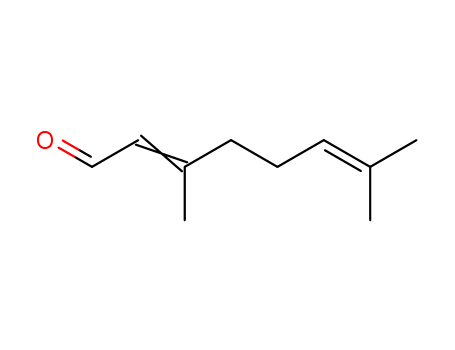Your Location:Home > Products > Flavors and fragrances > Citral



CasNo: 5392-40-5
MF: C10H16O
Appearance: yellow liquid
| Category | Citral is an aldehyde and belongs to the family of terpenoids. |
|
Description |
Citral (C10H16O), also known as 3,7-dimethyl-2,6-octadienal, is a clear yellow liquid with a strong lemon-like odor. It is found in the essential oils of plants such as lemongrass, Litsea cubeba, and lemon oil. Citral is commercially significant due to its diverse applications in the food, cosmetic, and pharmaceutical industries. It consists of two geometric isomers: Neral (cis) and Geranial (trans), which together give it its characteristic citrus scent. |
| Reactivity | Citral is reactive with strong acids and bases. It can undergo oxidation to form carboxylic acids and may self-condense or polymerize. |
| Uses | Citral is widely used as a natural flavoring agent in various food and beverage products like soft drinks, baked goods, candies, and chewing gum. It is particularly used to impart a lemon or citrus flavor. Approved by the FDA as a food safety ingredient due to its antimicrobial and antioxidant properties. Citral has potent antibacterial properties and is used to control pathogens such as Yersinia enterocolitica in food. Its mode of action involves increasing the production of reactive oxygen species (ROS), disrupting cell membranes, and inhibiting protein synthesis in bacteria. |
| Toxicity | Moderately toxic by ingestion (LD50: 4960 mg/kg in rats), and can cause skin irritation. Citral is a potential allergen and is classified as a skin irritant. It is also a questionable carcinogen. |
| Synthetic Production | Citral can be synthesized from geraniol, dehydrolinalool, or methyl heptenone through various chemical reactions, such as vapor-phase dehydrogenation, oxidation, and rearrangement reactions. Orchid Chemical Supplies Ltd was established in 2009.After more than 15 years of business accumulation, we have established good business relationships with over 25500 major factories in China. |
InChI:InChI=1/2C10H16O/c2*1-9(2)5-4-6-10(3)7-8-11/h2*5,7-8H,4,6H2,1-3H3/b10-7+;10-7-
Citral is biosynthesized by the plants through the 5 carbon precursor isopentenyl diphosphate (IPP) units utilizing two diverse biochemical pathways, acetate– mevalonate (acetate– MVA) pathway or 2C-methylerythritol-4-phosphate (MEP). Orally Citral was absolutely digested in the gastrointestinal tract and its metabolism leads to the discharge of metabolites which include a number of acids and a biliary glucuronide.
In this study, citral, a food safety ingredient approved by the FDA, was found to exert inhibitory activity against five Y. enterocolitica strains, with MIC values of 0.2–0.4 mg/mL (Table 2). Previous studies have explored the inhibitory effects of other natural compounds on Y. enterocolitica. The findings of Tian et al. (2021) indicated that the MIC of chlorogenic acid on Y. enterocolitica was 2.5 mg/mL.
Abstract: In this work, the catalytic ac...
quinoline

meta-dinitrobenzene

Geraniol

sodium carbonate

4,8-dimethyl-1,3,7-nonatriene

1,1-diethoxy-3,7-dimethylocta-2,6-diene

1-(5-benzyl-[2]thienyl)-5,9-dimethyl-deca-2,4,8-trien-1-one

9,13-dimethyl-tetradeca-111,6,8,12-tetraen-5-one